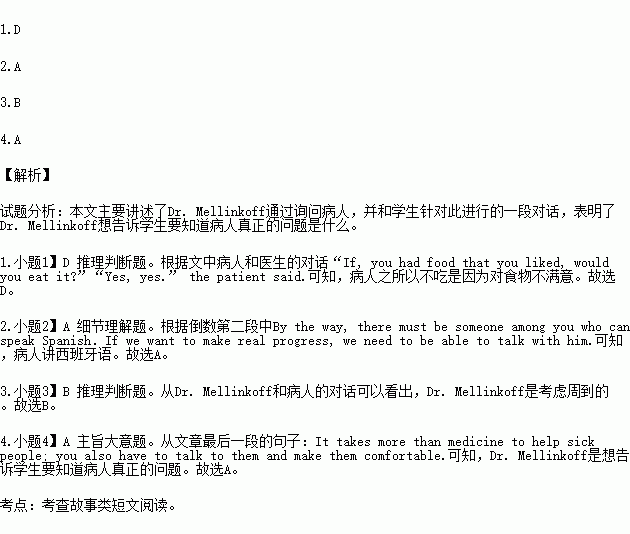题目内容
Once Dr. Mellinkoff invited me to join him at the hospital to discuss interesting cases with his students. The case at hand was a Guatemalan man, aged 34, who had a fever and many other medical problems. His condition was not improving, and there was not much hope he would live.
Dr. Mellinkoff asked to see the patient. He introduced himself in Spanish and, in a very gentle voice, asked how he felt. The patient smiled and said everything was all right. Then the doctor asked if he was able to eat. The patient said that he had no desire to eat.
“Are you getting food you like?”
The patient said nothing.
“Do you get the kind of food you have at home?”
The answer was no.
The doctor put his hand on the man’s shoulder and his voice was very soft.
“If, you had food that you liked, would you eat it?”
“Yes, yes.” the patient said.
The change in the patient’s appearance couldn’t have been more obvious. Nothing was said, but it was easy to tell that a message had been sent and had also been received.
Later, the doctor asked why the Guatemalan man wasn’t getting food he could eat. One of the students said, “We all know how difficult it is to get the kitchen to make special meals.”
“Suppose, ” the doctor replied, “you felt a certain medicine was absolutely necessary but that our hospital didn’t carry it, would you accept defeat or would you insist the hospital meet your request?”
“I would probably insist, ” the student said.
“Very well, ” the doctor said. “You might want to try the same method in the kitchen. It won’t be easy, but I can help you. Meanwhile, let’s get some food inside this man as fast as possible, and stay with it. Or he’ll be killed by hunger. By the way, there must be someone among you who can speak Spanish. If we want to make real progress, we need to be able to talk with him.”
Three weeks later, Dr. Mellinkoff told me that the Guatemalan man had left the hospital under his own power. It takes more than medicine to help sick people; you also have to talk to them and make them comfortable.
1.The patient had no desire to eat because ________.
A. he was not hungry
B. he was seriously ill
C. he was given special meals
D. he was not satisfied with the food
2.According to the passage, we can conclude that ________.
A. the patient was from another country
B. the patient’s illness was caused by hunger
C. Dr. Mellinkoff performed an operation on the patient
D. the hospital failed to provide the right medicine for the patient
3.Which of the following words can be used to describe Dr. Mellinkoff?
A. Cold. B. Considerate. C. Curious. D. Confident.
4.What do you think Dr. Mellinkoff wanted to tell his students in this case?
A. Doctors should know their patients’ real problems.
B. Doctors should be able to speak foreign languages.
C. Doctors should try to improve their medical skills.
D. Doctors should give more medicine to patients.
 孟建平小学滚动测试系列答案
孟建平小学滚动测试系列答案 黄冈天天练口算题卡系列答案
黄冈天天练口算题卡系列答案
